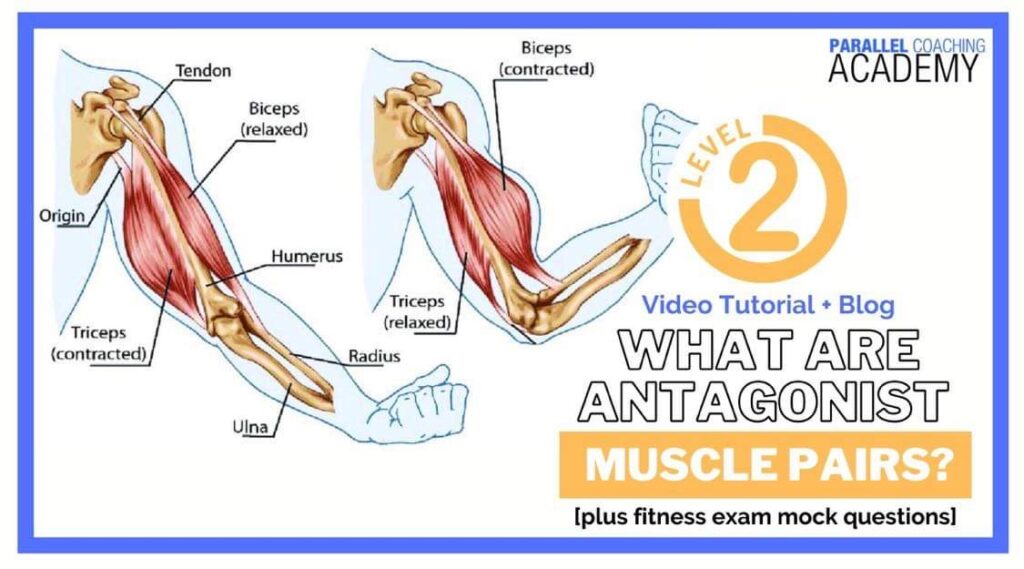This blog will teach you all about Antagonist muscle pairs so you can be prepared for your Level 2/ 3 Anatomy exam and understand when planning supersets for clients.
You will need to know how the blood flows that muscles work in pairs using reciprocal inhibition and that every agonist muscle has an antagonist muscle pair.
At the bottom of this blog, you’ll also find three mock questions to test your knowledge
Watch the 8 minute video about Antagonist Muscle Pairs
What is an Antagonist Muscle?
Essentially the Antagonist muscle is the opposing muscle to the Agonist. The Agonist is the main muscle moving in an exercise ( sometimes called the prime mover).
Every muscle can be an Agonist, and every muscle has an antagonist paired muscle.
Muscles work in pairs, whilst one works (contracts) the other relaxes. This is kinda like a conversation, whilst one person is talking, the other person listens; it doesn’t work if both people are trying to talk at the same time.
Through reciprocal inhibition one of the muscles in the pair contracts, whilst the other muscle relaxes.
Reciprocal inhibition is defined as the relaxation of muscles on one side of a joint to accommodate contraction on the other side.
To understand this, consider the Bicep Curl exercise:
The Prime Mover (or Agonist) is the Biceps Brachii.
When concentrically contracting (getting shorter) the Biceps Brachii creates Elbow flexion. In order to allow this elbow flexion, the Triceps Brachii (antagonist) has to relax and lengthen.
This means that the Biceps Brachii and Triceps Brachii are agonist-antagonist paired muscles.
So when we are analyzing a triceps extension exercise, the Triceps Brachii is the Prime mover (Agonist) that contracts, and the Biceps Brachii become the antagonist that relaxes and lengthens.
Examples of Antagonist Muscle Pairs
- Biceps Brachii vs Triceps Brachii (elbow flexion vs elbow extension)
- Hamstrings vs Quadriceps (knee flexion vs knee extension)
- Gluteus Maximus vs Hip flexor/ Iliopsoas (hip extension vs hip flexion)
- Gastrocnemius vs Anterior Tibialis (Dorsifelxion vs Plantarflexion)
- Pectoralis Majors vs Mid Trapezius (shoulder horizontal flexion vs shoulder horizontal extension)
- Deltoids vs Latissiumus Dorsi (shoulder flexion and abduction vs shoulder extension and adduction)
- Rectus Abdominus vs Erector Spinae (spine flexion vs spine extension)
Test your knowledge with three mock questions:
[NOTE: The answers are below the 3rd questions]
Q1: Which of the following is the antagonist if Biceps Brachii is the agonist?
A. Triceps Brachii
B. Rectus Femoris
C. Biceps Femoris
D. Brachioradialis
Q2: According to the rule of Recipricol Inhibition, what happens to the antagonistic muscle when agonist concentrically contracts?
A. Eccentric Contraction
B. Concentric Contraction
C. Relax and lengthen
D. Relax and shorten
Q3: What would be a suitable agonist-antagonist pairing if the Shoulder Press was the first exercise?
A. Biceps Curl
B. Lat Pull Down
C. Leg Extension
D. Seated Row
Answers to the mock questions are :
Question 1= A, Question 2 = C, Question 3 = B
If you want more mock questions like this, then you can download more Free Mock Questions: DOWNLOAD NOW
Need More Help with your Level 3 Anatomy Revision?
For Trainee FITPROS Taking Their L3 Anatomy & Physiology Exam.
Learn, Revise & Pass Your Level 3 Anatomy & Physiology Exam In Under 10-hours
(Without Having To Spend Hours Revising Or Feeling Overwhelmed)
If you want to get your revision structured, learn everything you need to know, and feel confident on exam day, then click the link below:

Dedicated to More
Hayley “Antagonist Muscle Pairs” Bergman
Parallel Coaching
P.S. You can also find us on the following platforms:
Instagram: Follow Now
Facebook: Like Our Page
Twitter: Tweet Us
YouTube: Subscribe Here
More Muscles Blogs: HERE

